50 Years Ago: Apollo 14 Splashdown and Recovery
On Feb. 9, 1971, the nine-day Apollo 14 Moon-landing mission came to a successful conclusion with the splashdown of astronauts Alan B. Shepard, Stuart A. Roosa, and Edgar D. Mitchell aboard their Command Module (CM) Kitty Hawk in the south Pacific Ocean. Recovery forces aboard the prime recovery ship U.S.S. New Orleans monitored the descent and splashdown and retrieved the crew and the spacecraft. As part of the back contamination procedures, the astronauts entered a Mobile Quarantine Facility (MQF) aboard the New Orleans immediately after recovery. The astronauts were flown by helicopter to American Samoa from the recovery ship, where they boarded a second MQF and flew to Ellington Air Force Base in Houston. They completed the remainder of their 21-day quarantine in the Lunar Receiving Laboratory (LRL) at the Manned Spacecraft Center (MSC) in Houston, now NASA’s Johnson Space Center.
When Shepard, Roosa, and Mitchell awoke for their ninth and final day in space, Apollo 14 had closed the distance to Earth to 63,000 miles and accelerated to more than 5,500 mph. The crew’s last nine hours in space went calmly, with the astronauts completing the final stowage of the cabin and making the final navigation sightings. In the Mission Control Center (MCC) at MSC, Flight Director Milton L. Windler’s controllers, known as the Maroon Team, arrived on console for the final shift of the mission, with Bruce McCandless serving as the capsule communicator (capcom), the astronaut who spoke directly with the crew in space. In the MCC, communications specialists assessed the sudden loss of voice and data circuits with ground stations in the Pacific region and Australia. An earthquake registering 6.5 on the Richter scale rocked the Los Angeles area that morning and temporarily disrupted underwater cable communications for up to five minutes. Use of alternate ground stations and rapid rerouting of telephone lines ensured that no loss of support to Apollo 14 occurred.  Left: Apollo 14 Command Module (CM) Kitty Hawk descending under its three main parachutes. Middle: Kitty Hawk at the moment of splashdown. Right: A recovery swimmer attaches the flotation collar around the CM, with the still-attached parachute lines still visible. Credits: NASA
Left: Apollo 14 Command Module (CM) Kitty Hawk descending under its three main parachutes. Middle: Kitty Hawk at the moment of splashdown. Right: A recovery swimmer attaches the flotation collar around the CM, with the still-attached parachute lines still visible. Credits: NASA
After checking the status of their spacecraft’s reaction control thrusters, they oriented their capsule to the proper attitude for separating the CM from the Service Module. At an altitude of 5,000 miles, now travelling at 16,400 mph, they commanded the pyrotechnics to fire, and Kitty Hawk was free. They immediately turned it around to the blunt-end forward orientation to ensure the capsule’s heat shield faced forward for atmospheric entry. Reaching a peak velocity of 24,600 mph, Kitty Hawk encountered the upper layers of Earth’s atmosphere at an altitude of about 400,000 feet. The spacecraft’s motion compressed the molecules of the thin air to create a sheath of plasma around the capsule, blocking out communications for about three-and-a-half minutes. While outside the capsule temperatures soared to 5,000 degrees Fahrenheit (F), inside it remained a comfortable 71 degrees F. Due to the rapid deceleration, the astronauts experienced a maximum force of 6.75 gs. At 40,000 feet, two drogue parachutes opened to slow and stabilize the capsule, followed by the three 83-foot diameter main parachutes at 10,000 feet. They established radio contact with forces from the prime recovery ship, the U.S.S. New Orleans, who made visual contact with the spacecraft descending on its orange-and-white parachutes. The capsule splashed down in the south Pacific Ocean, the southernmost splashdown of the Apollo program, just east of the international date line. Two of the parachutes detached from the capsule and, although the lines from the third one ended up draped over it, the spacecraft remained in the Stable 1, or apex-up orientation. Apollo 14’s mission lasted nine days and two minutes.
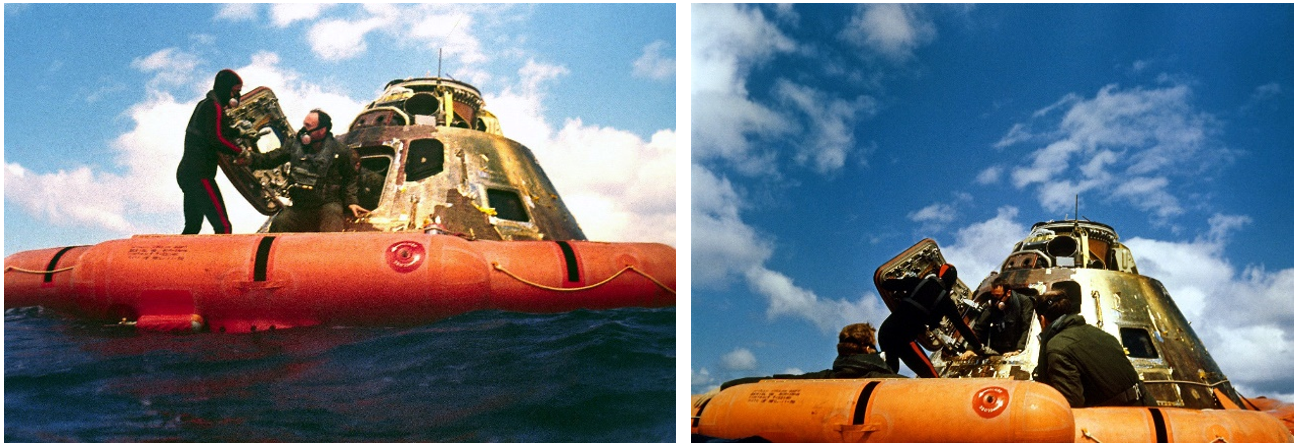 Left: Recovery swimmer assisting Apollo 14 astronaut Edgar D. Mitchell out of the CM Kitty Hawk and into the life raft, with Stuart A. Roosa right behind him. Right: Swimmer assists Alan B. Shepard out of the CM and into the life raft where Roosa, left, and Mitchell await him. Credits: NASA
Left: Recovery swimmer assisting Apollo 14 astronaut Edgar D. Mitchell out of the CM Kitty Hawk and into the life raft, with Stuart A. Roosa right behind him. Right: Swimmer assists Alan B. Shepard out of the CM and into the life raft where Roosa, left, and Mitchell await him. Credits: NASA
 Left: View from a recovery helicopter of the CM Kitty Hawk and Apollo 14 astronauts Edgar D. Mitchell, left, Stuart A. Roosa, and Alan B. Shepard in the life raft. Middle: In the hangar deck of the U.S.S. New Orleans, Roosa, left, Mitchell, and Shepard descend from the recovery helicopter to make their way to the MQF. Right: Roosa, left, Shepard, and Mitchell inside the MQF during the welcome home ceremony aboard the New Orleans. Credits: NASA
Left: View from a recovery helicopter of the CM Kitty Hawk and Apollo 14 astronauts Edgar D. Mitchell, left, Stuart A. Roosa, and Alan B. Shepard in the life raft. Middle: In the hangar deck of the U.S.S. New Orleans, Roosa, left, Mitchell, and Shepard descend from the recovery helicopter to make their way to the MQF. Right: Roosa, left, Shepard, and Mitchell inside the MQF during the welcome home ceremony aboard the New Orleans. Credits: NASA
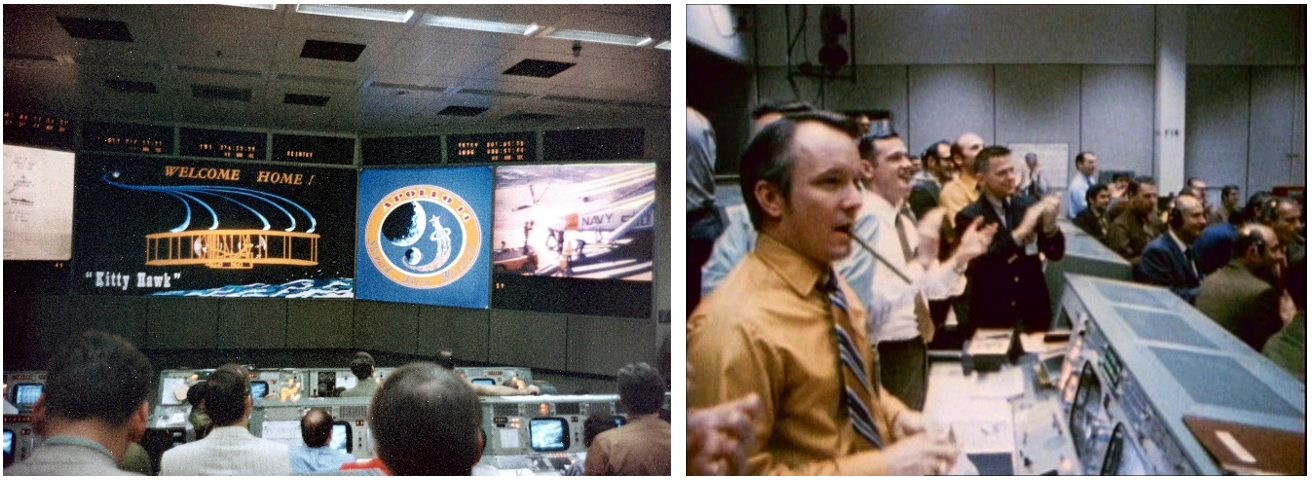 Left: View in the MCC at the Manned Spacecraft Center after the Apollo 14 splashdown. Right: In the MCC, Flight Directors Gerald D. “Gerry” Griffin, left, Glynn S. Lunney, and M.P. “Pete” Frank, along with dozens of controllers, managers, and astronauts, celebrate the successful conclusion of the Apollo 14 mission. Credits: NASA
Left: View in the MCC at the Manned Spacecraft Center after the Apollo 14 splashdown. Right: In the MCC, Flight Directors Gerald D. “Gerry” Griffin, left, Glynn S. Lunney, and M.P. “Pete” Frank, along with dozens of controllers, managers, and astronauts, celebrate the successful conclusion of the Apollo 14 mission. Credits: NASA
Recovery helicopters from the New Orleans arrived within minutes, and swimmers jumped into the water to first attach a sea anchor to the capsule, followed by cutting the remaining parachute line. They attached a flotation collar around the base of the capsule. The decontamination swimmer arrived to open the capsule’s hatch and hand the crew their breathing apparatuses and clean flight suits, part of the postflight back-contamination prevention protocol. Wearing the fresh overalls and masks, first Mitchell, then Roosa, and finally Shepard exited their spacecraft and climbed aboard the life raft. A recovery helicopter dropped the Billy Pugh net to retrieve each astronaut from the raft: first Roosa, then Mitchell, and finally Shepard. With all three aboard, the helicopter flew to the New Orleans, arriving there 48 minutes after splashdown. On the deck, sailors towed the helicopter to an elevator that took it below to the hangar deck. Once the helicopter reached its final position, Shepard, Mitchell, and Roosa emerged, and all three walked the few steps to the waiting MQF. NASA Flight Surgeon Dr. William R. Carpentier and support engineer Ralph Culbertson from MSC’s Landing and Recovery Division joined them in the MQF. In the MCC, the usual pandemonium erupted once Shepard, Roosa, and Mitchell arrived on the recovery ship.
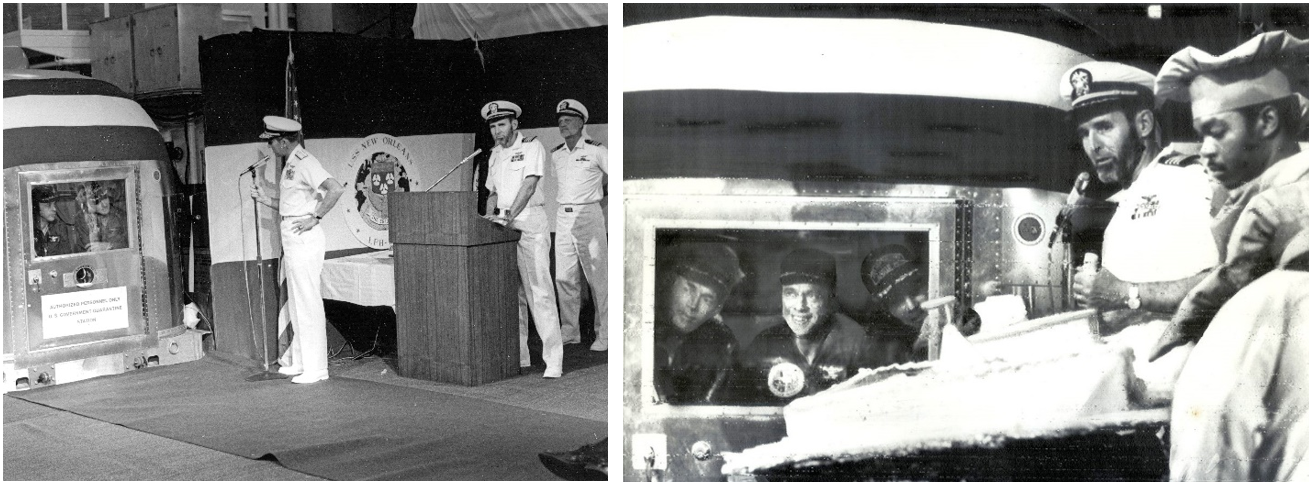 Left: Aboard the U.S.S. New Orleans, commander of the recovery task force, Rear Adm. Thomas B. Hayward, center, welcomes Apollo 14 astronauts Stuart A. Roosa, left, Alan B. Shepard, and Edgar D. Mitchell back to Earth, as Capt. Robert E. Moore, commander of the New Orleans, looks on from the podium. Right: Capt. Moore presents a cake to Roosa, left, Shepard, and Mitchell in the MQF. Credits: NASA
Left: Aboard the U.S.S. New Orleans, commander of the recovery task force, Rear Adm. Thomas B. Hayward, center, welcomes Apollo 14 astronauts Stuart A. Roosa, left, Alan B. Shepard, and Edgar D. Mitchell back to Earth, as Capt. Robert E. Moore, commander of the New Orleans, looks on from the podium. Right: Capt. Moore presents a cake to Roosa, left, Shepard, and Mitchell in the MQF. Credits: NASA
Once inside the MQF, Shepard, Roosa, and Mitchell removed their respirators and took their first showers in nine days. Dr. Carpentier gave each a physical exam and declared them all healthy. Capt. Robert E. Moore, commanding officer of the New Orleans, officiated at a welcoming ceremony for the Apollo 14 astronauts, including speeches by Rear Adm. Thomas B. Hayward, commander of the recovery task force, Gen. John D. Stephenson from the Office of Manned Space Flight at NASA Headquarters in Washington, D.C., and Houston Mayor Louie Welch. President Richard M. Nixon telephoned them with congratulations on the success of their mission and invited them to a dinner at the White House.
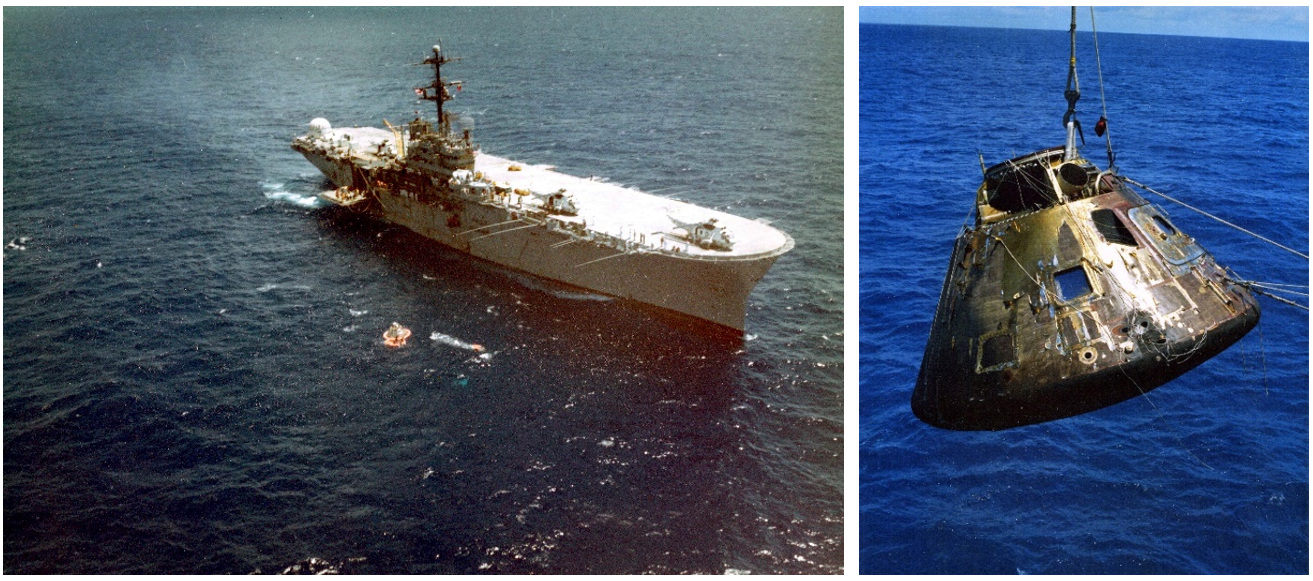 Left: The U.S.S. New Orleans as it’s about to retrieve the Apollo 14 CM Kitty Hawk. Right: Sailors lift Kitty Hawk out of the ocean to bring it aboard the New Orleans. Credits: NASA
Left: The U.S.S. New Orleans as it’s about to retrieve the Apollo 14 CM Kitty Hawk. Right: Sailors lift Kitty Hawk out of the ocean to bring it aboard the New Orleans. Credits: NASA
Recovery forces retrieved the CM Kitty Hawk from the ocean and brought it aboard the New Orleans 76 minutes after the crew. Sailors towed it below to the hangar deck and parked it near the MQF. Engineers from MSC’s Landing and Recovery Division erected a flexible tunnel between the MQF and the spacecraft to allow for the retrieval of the lunar sample and film magazines. These were then passed to the outside through the MQF’s airlock and placed aboard aircraft to be flown back to Houston as quickly as possible. After completing the recovery operations, the New Orleans sailed toward American Samoa.
Two days later, as the carrier approached within helicopter range, Shepard, Roosa, and Mitchell, along with Dr. Carpentier and MQF engineer Culbertson, wearing respirators to maintain some isolation, exited the MQF and boarded the chopper for the flight to Pago Pago. They had been aboard the MQF for 41 hours. At Pago Pago International Airport, cheered on by a welcoming crowd that included Samoan dancers, the five of them walked the short distance to a second MQF aboard a C-141 transport plane. After refueling in California, the C-141 landed at Houston’s Ellington Air Force Base on Feb. 12.
This unusual protocol, different from the process used after Apollo 11 and 12, saved about 30 hours of transit time for the astronauts. In total, they spent 59 hours inside the MQF. Meanwhile, the New Orleans sailed on to Honolulu and, upon arrival there on Feb. 17, sailors offloaded the CM Kitty Hawk and the first MQF. The MQF was flown to Houston, arriving there the next day, while the spacecraft was taken first to Hickam Air Force Base on Oahu in Hawaii for deactivation before finally arriving in Houston on Feb. 22.
 Left: Aboard the U.S.S. New Orleans, Apollo 14 astronauts Alan B. Shepard, left, Stuart B. Roosa (partially hidden behind Shepard), and Mitchell, along with Flight Surgeon Dr. William R. Carpentier and engineer Ralph Culbertson, prepare to board a helicopter for the flight to Pago Pago, American Samoa. Middle: At Pago Pago International Airport, Samoan dancers greet Carpentier, left, Culbertson, Roosa, Mitchell, and Shepard as they walk from the helicopter to the second MQF aboard a C-141 transport jet. Right: Roosa, left, Shepard, and Mitchell peer out of the MQF aboard the C-141 before their departure for Houston. Credits: NASA
Left: Aboard the U.S.S. New Orleans, Apollo 14 astronauts Alan B. Shepard, left, Stuart B. Roosa (partially hidden behind Shepard), and Mitchell, along with Flight Surgeon Dr. William R. Carpentier and engineer Ralph Culbertson, prepare to board a helicopter for the flight to Pago Pago, American Samoa. Middle: At Pago Pago International Airport, Samoan dancers greet Carpentier, left, Culbertson, Roosa, Mitchell, and Shepard as they walk from the helicopter to the second MQF aboard a C-141 transport jet. Right: Roosa, left, Shepard, and Mitchell peer out of the MQF aboard the C-141 before their departure for Houston. Credits: NASA
Despite the early hour, 4:30 a.m., and the chilly breeze, an enthusiastic crowd, including the astronauts’ families and a marching band, turned out at Ellington to welcome Shepard, Roosa, and Mitchell back home to Houston. A flatbed truck transported Shepard, Roosa, and Mitchell in the MQF to the LRL at MSC for them to continue their quarantine in more spacious quarters. In the LRL, the astronauts examined some of the Moon rocks Shepard and Mitchell had collected and began the postflight debriefings.
Once Kitty Hawk arrived, they were able to examine their spacecraft. Finding no evidence of lunar microorganisms, on Feb. 27, flight surgeons released Shepard, Roosa, and Mitchell from quarantine and cleared the lunar samples for release to scientists on April 4. On April 28, NASA announced that crews, beginning with Apollo 15, would no longer be required to undergo the three-week postflight quarantine, as scientists found no evidence of any lunar microorganisms in any of the samples returned by the first three landing missions.
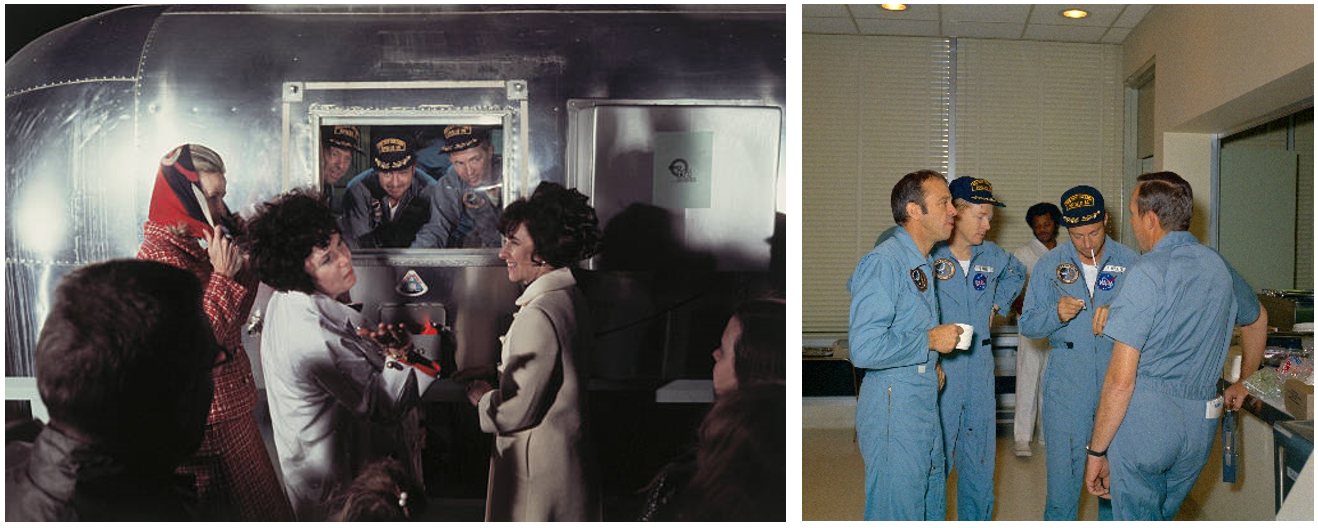 Left: From inside the MQF, Apollo 14 astronauts Alan B. Shepard, left, Edgar D. Mitchell, and Stuart A. Roosa greet their wives Louise Shepard, left, Joan Roosa, and Louise Mitchell upon their arrival at Ellington Air Force Base in Houston. Right: Shepard, left, Roosa, and Mitchell after their arrival in the LRL at the MSC. Credits: NASA
Left: From inside the MQF, Apollo 14 astronauts Alan B. Shepard, left, Edgar D. Mitchell, and Stuart A. Roosa greet their wives Louise Shepard, left, Joan Roosa, and Louise Mitchell upon their arrival at Ellington Air Force Base in Houston. Right: Shepard, left, Roosa, and Mitchell after their arrival in the LRL at the MSC. Credits: NASA
 Left: On the loading dock of the LRL at the MSC, engineers deliver the lunar samples and film returned from the Apollo 14 mission. Middle: In the LRL, Apollo 14 astronauts Edgar D. Mitchell, left, Stuart A. Roosa, and Alan B. Shepard examine lunar samples they collected in the Fra Mauro region of the Moon. Right: In the Nonsterile Nitrogen Laboratory in the LRL, technicians Linda Tyler, left, Nancy L. Trent, and Sandra Richards peer through the glass at a basketball-sized rock returned by the Apollo 14 astronauts. Credits: NASA
Left: On the loading dock of the LRL at the MSC, engineers deliver the lunar samples and film returned from the Apollo 14 mission. Middle: In the LRL, Apollo 14 astronauts Edgar D. Mitchell, left, Stuart A. Roosa, and Alan B. Shepard examine lunar samples they collected in the Fra Mauro region of the Moon. Right: In the Nonsterile Nitrogen Laboratory in the LRL, technicians Linda Tyler, left, Nancy L. Trent, and Sandra Richards peer through the glass at a basketball-sized rock returned by the Apollo 14 astronauts. Credits: NASA
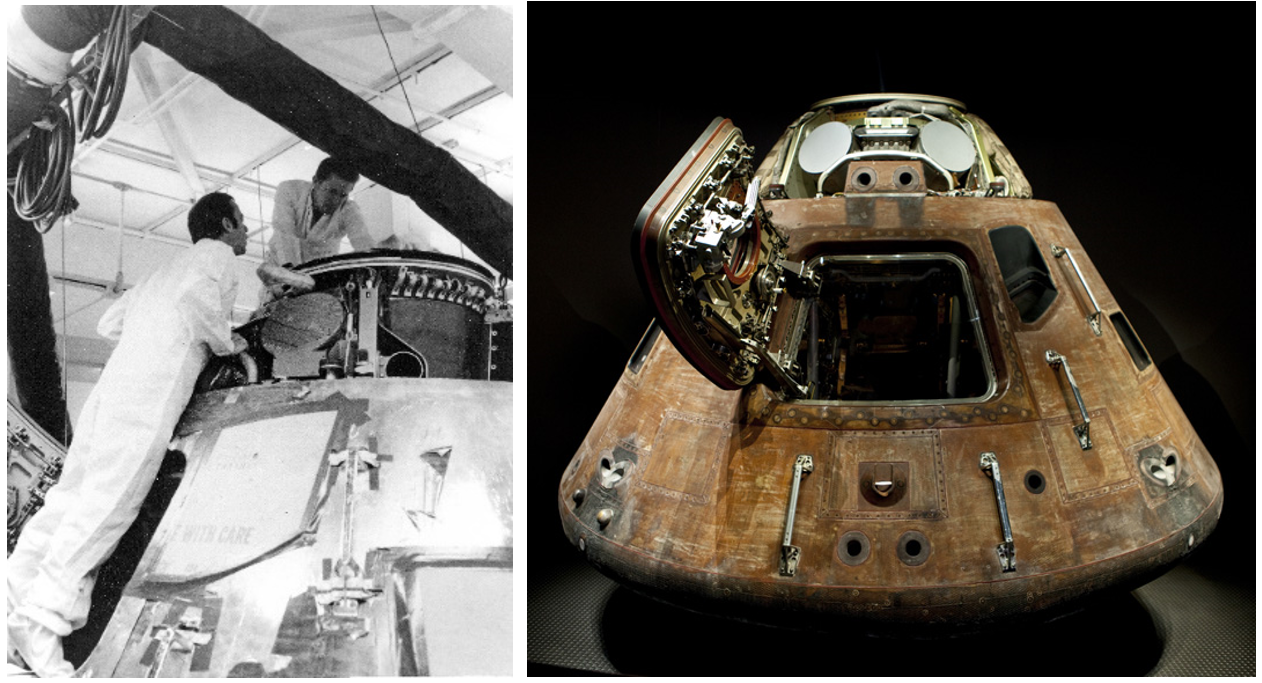 Left: In the LRL, Apollo 14 astronauts Alan B. Shepard, left, and Stuart A. Roosa examine their CM Kitty Hawk. Right: The Apollo 14 CM Kitty Hawk on display at the Visitor Complex at NASA’s Kennedy Space Center. Credits: NASA
Left: In the LRL, Apollo 14 astronauts Alan B. Shepard, left, and Stuart A. Roosa examine their CM Kitty Hawk. Right: The Apollo 14 CM Kitty Hawk on display at the Visitor Complex at NASA’s Kennedy Space Center. Credits: NASA
The Apollo 14 CM Kitty Hawk is on display at the Visitor Complex at NASA’s Kennedy Space Center.
To be continued …







